flowchart LR
A[UNCERTAINTY<br/>Organizations face<br/>skill uncertainty] --> B[IMITATION<br/>Look to other<br/>organizations]
B --> C[CULTURAL FILTERING<br/>Theories about<br/>skill types]
C --> D[SYSTEMATIC BIAS<br/>Asymmetric Trajectory<br/>Channeling]
D --> E[STRATIFICATION<br/>Reproduction of<br/>hierarchies]
style A fill:#ffebee
style E fill:#e8f5e8
style D fill:#fff3e0
Asymmetric Trajectory Channeling in Labor Markets:
Macro-Level Evidence for Skills-Based Stratification Reproduction
Roberto Cantillan & Mauricio Bucca
Sociology | Pontificia Universidad Católica de Chile

I. THE PUZZLE
The Puzzle: Labor Market Dynamism vs. Persistent Stratification
Contemporary labor markets exhibit unprecedented dynamism: technological advancements, globalization, and evolving industrial landscapes continually reshape the world of work [@kalleberg2011; @autor2015].
Yet foundational structures of occupational hierarchy and socio-economic stratification exhibit remarkable persistence and adaptive resilience [@tilly1998].
Central Paradox: How does stratification reproduce itself within dynamic change?
The Polarization Phenomenon
Labor markets exhibit skills-based polarization: high-cognitive and low-manual jobs expand while middle-skill jobs decline.
Traditional explanations focus on technological displacement and globalization as external forces.
Missing Piece: How do internal labor market processes actively reproduce this polarized structure?

Skills-Based Stratification
Evidence from Alabdulkareem et al. (2018)
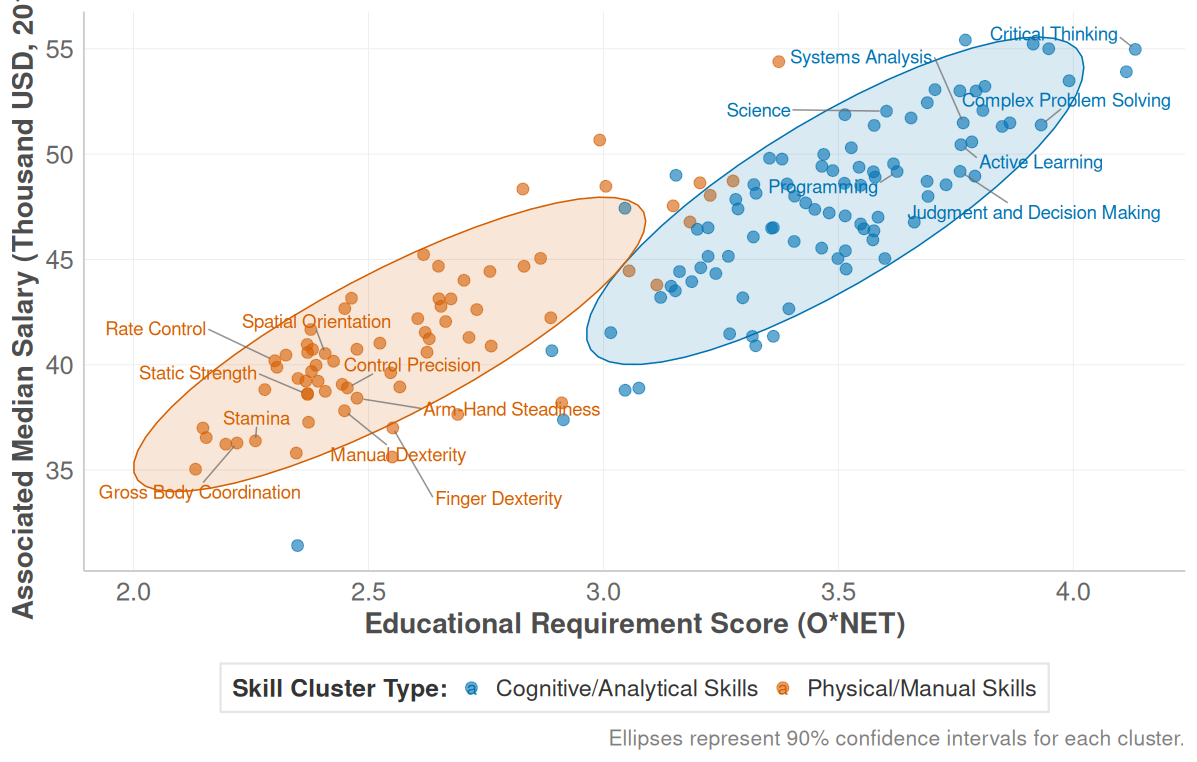
Some recent references
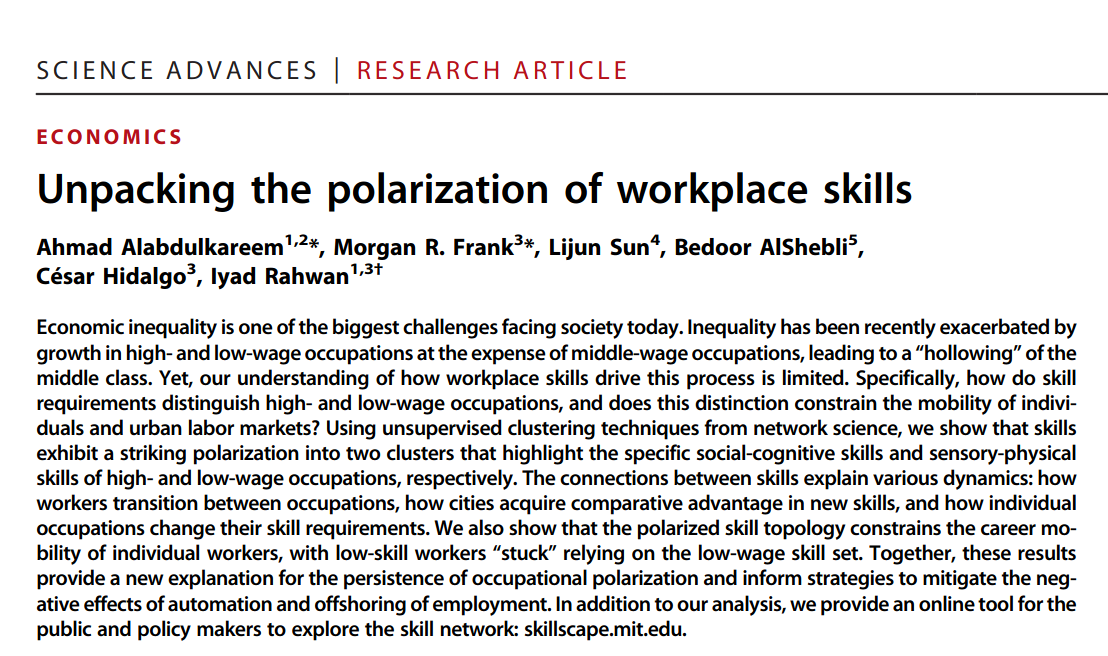
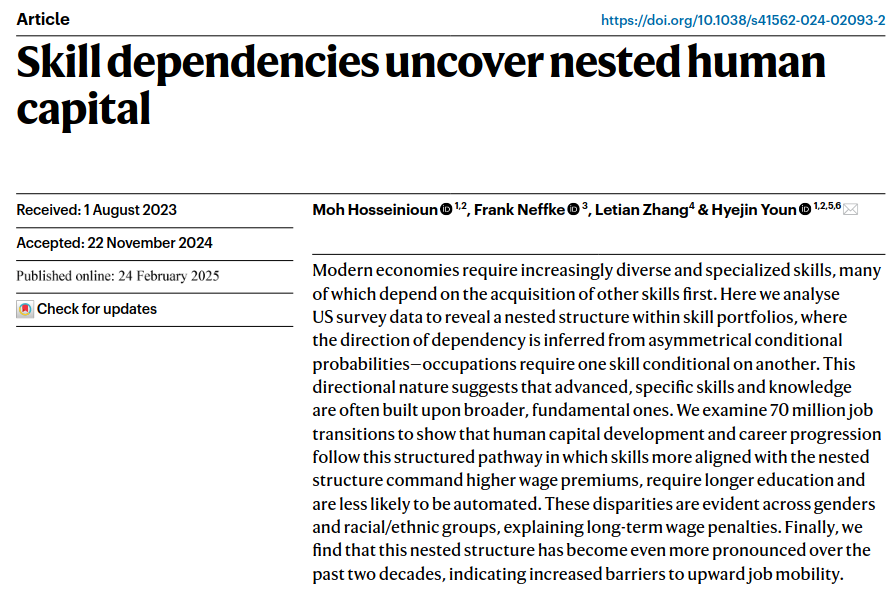
Supply-Side vs. Demand-Side Approaches
Supply-Side Focus
“How do workers adapt to changing skill demands?”
- Individual career decisions
- Human capital investment
- Job search strategies
- Skill acquisition choices
- Focus: Worker adaptation to external changes
Demand-Side Focus (This Study)
“How do organizations systematically reproduce skill requirements?”
- Inter-organizational skill diffusion
- Systematic adoption barriers
- Structural filtering mechanisms
- Focus: How demand-side processes create stratification
Demand-Side Patterns Shape Supply-Side Possibilities
If skill diffusion follows structured patterns → mobility opportunities are structurally predetermined
If different skill types have distinct diffusion logics → career destinies depend on skill type, not just skill possession
- Implication: The skill diffusion process itself becomes a stratification engine that sorts workers into persistent hierarchies.
Research Question
Do different skill types exhibit systematic asymmetries in their diffusion patterns across occupational hierarchies that reproduce labor market stratification?
Asymmetric Trajectory Channeling: Core Concept
Asymmetric Trajectory Channeling: The systematic tendency for different skill types to follow distinct diffusion pathways across occupational hierarchies, creating biased opportunity structures.
Trajectory
- Skills don’t diffuse randomly
- Follow structured pathways across status levels
Channeling
- Systematic filtering of diffusion flows
- Creates predictable adoption patterns
Asymmetric
- Different skill types = different patterns
- Cognitive: Upward escalation
- Physical: Lateral containment
Stratification Consequence:
These channeling patterns create structurally biased opportunities. Workers’ career destinies depend not just on skill possession, but on which type of skills they possess.
From Static Structure to Dynamic Process
Previous Research: Shows WHAT the structure (e.g., polarization) looks like.
This Research: Reveals HOW boundaries are actively constructed through skill diffusion between organizations.
Central Insight:
Occupational stratification isn’t just maintained—it’s dynamically reproduced through systematically biased skill adoption patterns on the demand side.
II. THEORETICAL FRAMEWORK
From Organizational Imitation to Stratification Reproduction
The Causal Chain
1.Organizational Uncertainty
- Which skills should we adopt?
- Limited information about effectiveness
- Look to other organizations for guidance
2.Cultural Theorization Filter
- Cognitive skills = “portable assets”
- Physical skills = “context-dependent”
- These beliefs bias imitation patterns
3.Systematic Imitation Bias
- Cognitive: Aspirational models (upward)
- Physical: Proximity models (lateral)
- Not random copying - culturally filtered
4.Macro-Level Outcome
- Micro-decisions aggregate into patterns
- Asymmetric Trajectory Channeling
- Demand-side reproduction of stratification
The Dual-Process Theory of Skill Diffusion
Cognitive Skills “Portable Assets”
- Cultural Theory: Nested capabilities, broadly applicable
- Organizational Logic: Growth & adaptability signals
- Diffusion Pattern: Aspirational Emulation
- Expected Result: Upward Escalator Effect
Physical Skills “Context-Dependent”
- Cultural Theory: Situational competencies, material constraints
- Organizational Logic: Functional proximity requirements
- Diffusion Pattern: Proximity-Based Adoption
- Expected Result: Lateral Containment Effect
Testable Prediction:
If cultural theorization drives organizational imitation, we should observe systematically different diffusion trajectories for cognitive vs. physical skills across occupational hierarchies.
Modeling the Empirical Pattern: Piecewise Approach
Expected Pattern: If cultural theorization drives organizational imitation, we should observe systematically different diffusion trajectories for different skill types.
Mathematical Formulation: We model the probability that a skill of type c diffuses from source occupation i to target occupation j:
\[\text{logit}\, P_{i \to j}^{(c)} = \theta_{0c} - \lambda_c d_{ij} - \beta_c^+ \Delta^+_{ij} - \beta_c^- \Delta^-_{ij}\]
Key Innovation - Piecewise Variables:
\(\Delta^+_{ij} = \max(0, s_j - s_i)\) (upward status moves)
\(\Delta^-_{ij} = \max(0, s_i - s_j)\) (downward status moves)
These are orthogonal (\(\Delta^+ \cdot \Delta^- = 0\) always)
Test: Asymmetric channeling = \((\beta_c^+ - \beta_c^-)\) differs systematically by skill type
Analytical Strategy
Core Challenge: Test whether cognitive and physical skills follow systematically different diffusion trajectories across occupational hierarchies
Identification Logic:
- Compare diffusion patterns across skill types within occupation pairs
- Leverage temporal structure (2015→2024 adoption patterns)
- Control for source occupation characteristics via fixed effects
Three-Step Empirical Architecture:
Step 1: Descriptive
- Cross-tabulation matrices
- Distance sensitivity analysis
- Raw channeling patterns
Step 2: Piecewise Models
- Asymmetric trajectory coefficients
- Orthogonal status variables (Δ⁺, Δ⁻)
- Skill-type specific estimation
Step 3: Causal Robustness
- Source occupation fixed effects
- Industry-level controls
- Alternative specifications
Key Innovation:
Piecewise approach breaks the functional symmetry constraint in single-gap models, allowing cognitive “escalation” \((β⁺)\) and “containment” \((β⁻)\) effects to be estimated independently.
III. METHODOLOGY
Data and Measurement Strategy
Data Sources:
- O-NET Database (2015-2024): Detailed skill requirements by occupation
- BLS Wage Data (2015-2023): Occupational wage levels
- Education Requirements: Systematic educational level mappings
Level of Analysis: Occupation-to-occupation skill diffusion events
Why Occupations? O*NET captures generalized skill requirements that organizations adapt, and occupations represent institutionalized roles with established skill expectations.
Temporal Design Logic & Empirical Validation
Why 2015→2024 Temporal Structure?
- Theoretical Motivation: Organizational imitation theory predicts systematic adoption patterns over time
- Empirical Foundation: Captures destination-focused channeling vs. traditional prediction approaches
- O-NET Methodology: Irregular but comprehensive update system across 9-year window
Empirical Validation of Genuine Change:
- 83.3% of occupation-skill combinations show significant importance rating changes
- 7,913 genuine adoption events identified (RCA transitions)
- 100% of skills demonstrate new adoption patterns
- 99.8% of occupations experience skill requirement changes
Methodological Strength:
- Dynamic data confirmed: O-NET 15.0→29.0 captures substantial skill evolution
- r = 0.98+ correlation with contemporaneous design validates structural patterns
- Robust evidence: Both micro-level changes and macro-level channeling patterns
Constructing the Skill Diffusion Dataset
Data Preparation
Step 1: Identify Skill Specialists
- RCA > 1 = occupation “effectively uses” skill
- 2015 baseline: Who has which skills?
- 2024 outcome: Who adopted new skills?
Step 2: Skill Type Classification
- Complementarity networks → Louvain, Leiden algorithms
- Robust result: 2 main clusters across methods
- Cognitive cluster: Critical thinking, complex problem solving
- Physical cluster: Manual dexterity, coordination
Event Construction
Step 3: Define Diffusion Opportunities
- Diffusion = 1: Target adopts (2024) what source had (2015)
- Diffusion = 0: Target could have adopted, but didn’t
- Universe: All possible source→target pairs by skill
Step 4: Measure Barriers/Facilitators
- Status gaps: Education & wage differences
- Structural distance: Overall skill profile similarity
- Test: Do gaps affect diffusion differently by skill type?
Goal: Create dyadic dataset of skill adoption opportunities between occupations
Final Dataset: ~1.5M occupation-pair-skill observations (10% sample due to computational constraints) tracking adoption patterns across occupational hierarchies
Final Dataset Structure
| source | target | skill_name | skill_cluster | diffusion | delta_up | delta_down | structural_distance | wage_gap |
|---|---|---|---|---|---|---|---|---|
| 11-1011.00 | 13-1111.00 | Critical Thinking | Socio-cognitive | 1 | 0.0 | 0.3 | 0.35 | -25000 |
| 11-1011.00 | 15-1252.00 | Critical Thinking | Socio-cognitive | 0 | 0.0 | 0.1 | 0.62 | -10000 |
| 27-1021.00 | 49-9071.00 | Manual Dexterity | Socio-technical | 0 | 0.0 | 0.5 | 0.75 | -10000 |
| 49-9071.00 | 51-2092.00 | Manual Dexterity | Socio-technical | 1 | 0.0 | 0.2 | 0.22 | -3000 |
| 13-1111.00 | 11-1011.00 | Active Listening | Socio-cognitive | 0 | 0.3 | 0.0 | 0.35 | 25000 |
| 51-2092.00 | 27-1024.00 | Arm-Hand Steady | Socio-technical | 1 | 0.1 | 0.0 | 0.28 | 15000 |
Final Dataset: ~1.5M skill-occupation dyadic events with piecewise status variables
Model Specification
Core Specification
We estimate separate models by skill type to identify systematic differences:
- Cognitive Model: Socio-cognitive skills.
- Physical Model: Socio-technical skills.
Key Parameters:
- β⁺: Effect of upward status moves.
- β⁻: Effect of downward status moves.
- Asymmetry Test:
(β⁺ - β⁻)by skill type.
Control Variables
To isolate status effects, we include:
- Structural Distance:
Similarity between occupations (2015 baseline). - Economic Gaps:
Wage and educational differences. - Fixed Effects:
Source occupation characteristics.
Robustness & Extensions
We validate our findings with several additional tests:
- Industry-level controls (4-digit NAICS).
- Alternative distance metrics.
- Bayesian shrinkage priors.
IV. RESULTS
Distance Sensitivity by Skill Type
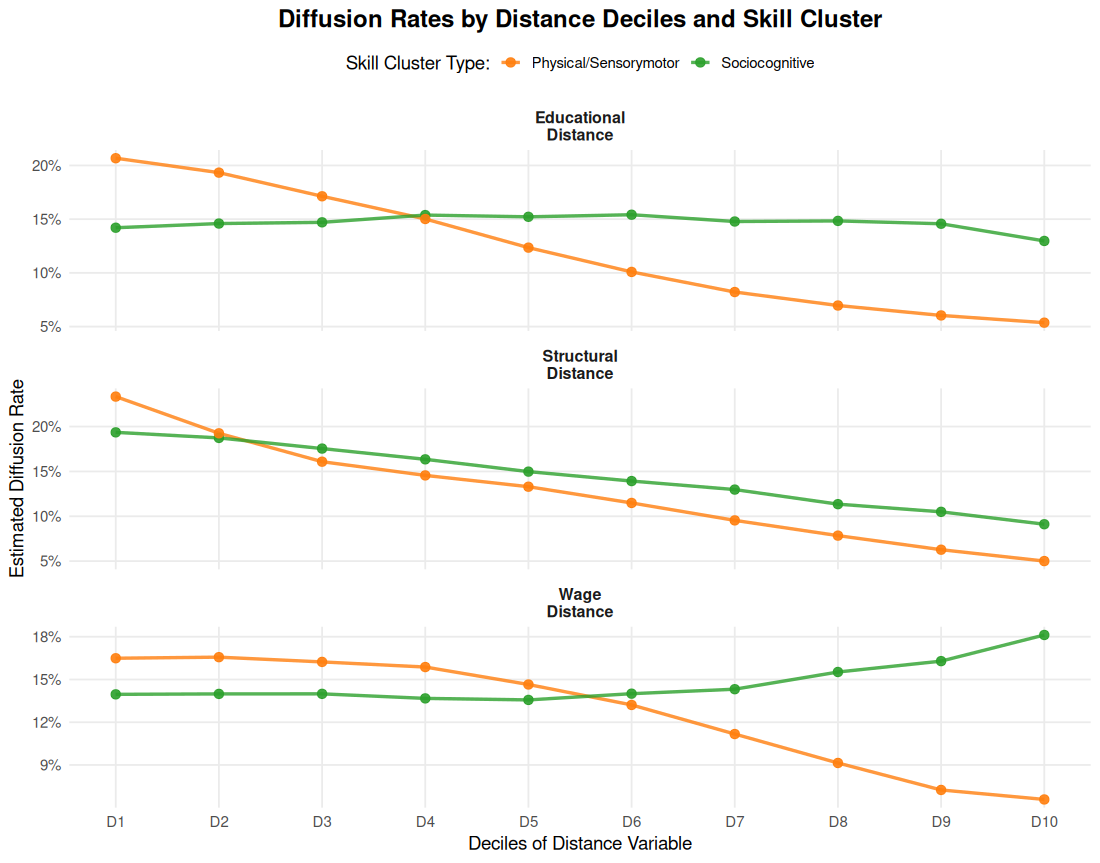
Distance Sensitivity by Skill Type
Key Patterns:
Socio-cognitive Skills (green): Maintain diffusion rates across distances, showing resilience to barriers
Socio-technical Skills (Orange): Show sensitivity to distance constraints with declining rates
Interpretation: Cognitive skills navigate structural barriers more effectively than physical skills
Matrix Evidence: Educational Channeling
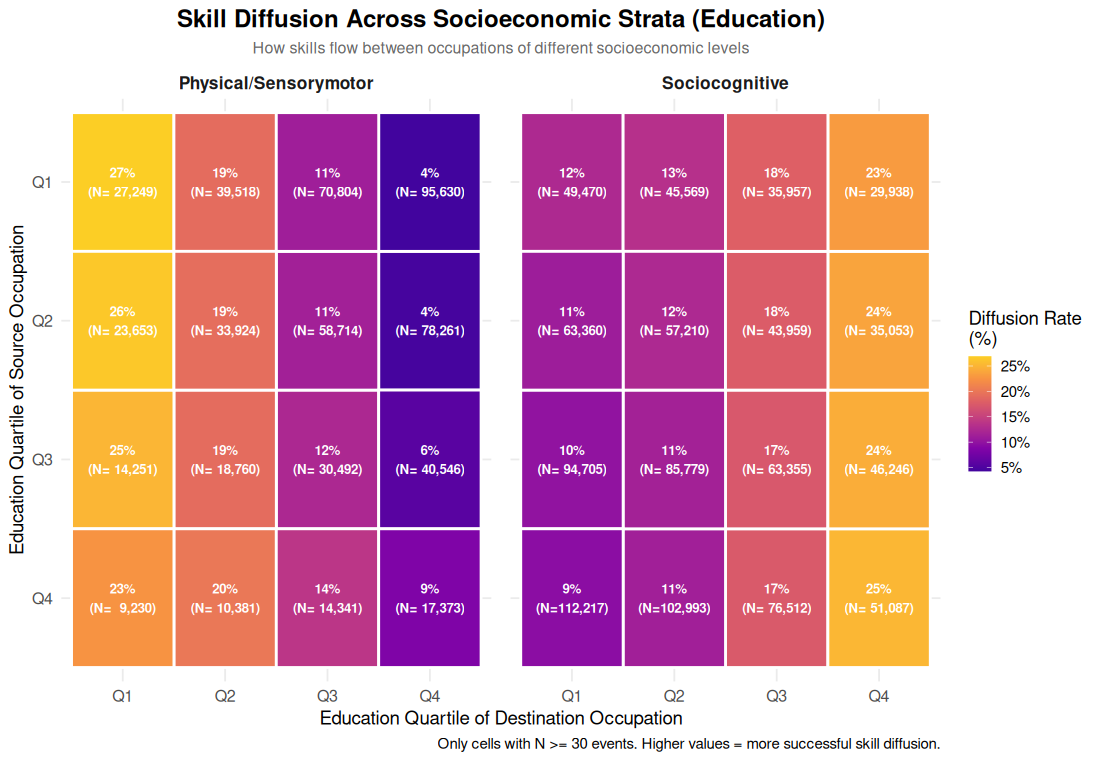
Matrix Evidence: Economic Channeling
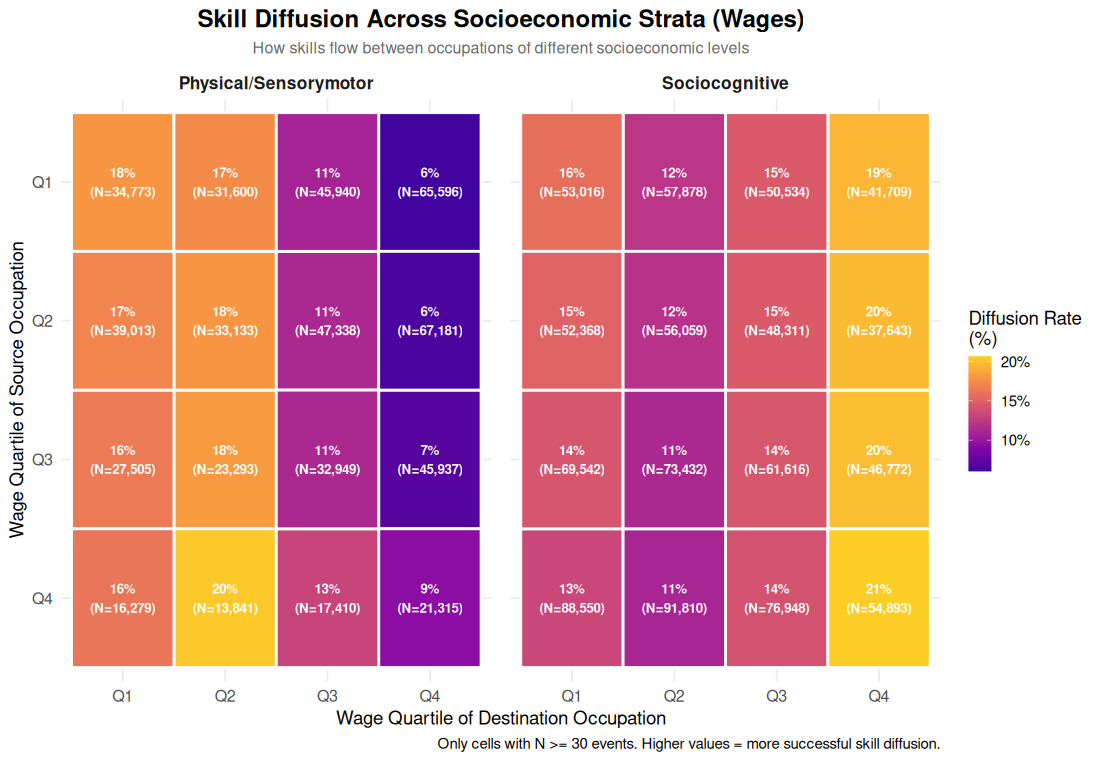
Descriptive Summary
Clear Asymmetric Patterns:
Socio-cognitive skills exhibit strong upward channeling, flowing predominantly toward high-education, high-wage occupations (Q4) regardless of origin
Socio-technical skills show lateral containment, circulating mainly within lower quartiles (Q1-Q3) with limited access to Q4
“Glass Ceiling” Effect: Physical skills face systematic barriers to entering high-status occupations
Next: Do these patterns hold when controlling for confounders?
Piecewise Model Results
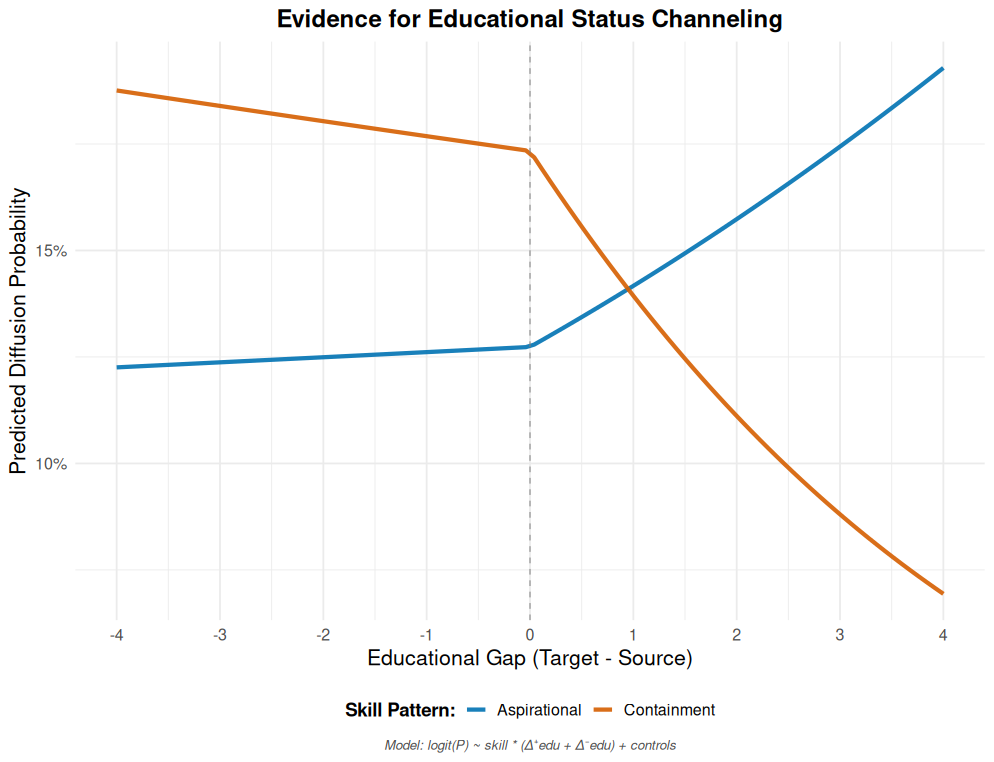
Piecewise Model Results II
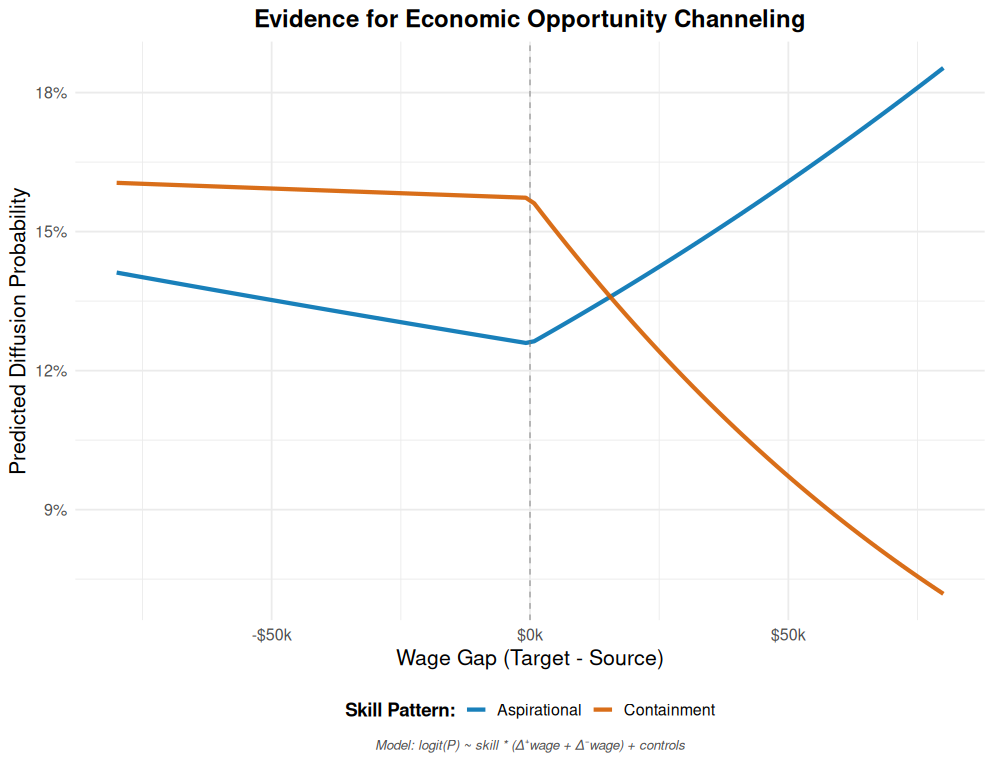
Confirmed Asymmetric Channeling
- Socio-cognitive Skills (Blue Line) = “The Escalator”:
- Sharp upward trajectory for positive status gaps (β⁺ = +0.444)
- Strong downward penalty for negative gaps (β⁻ = -0.258)
- Large Asymmetry: (β⁺ - β⁻) = 0.702
- Pattern: Strong aspirational pull toward higher-status occupations
- Socio-technical Skills (Orange Line) = “Lateral Containment”:
- Minimal upward facilitation (β⁺ = -0.122)
- Moderate downward penalty (β⁻ = -0.225)
- Small Asymmetry: (β⁺ - β⁻) = 0.103
- Pattern: Largely neutral/constrained mobility
- Minimal upward facilitation (β⁺ = -0.122)
Identification Strategy: Source Occupation Fixed Effects
Core Challenge: Do diffusion patterns reflect genuine channeling or unobserved occupation characteristics?
Solution: Source occupation fixed effects control for:
- Industry-specific demand factors
- Technological readiness levels
- Organizational resource constraints
- Historical skill specialization patterns
Identification: Within-source variation in target adoption patterns by skill type
Result: Asymmetric channeling persists within source occupations, confirming systematic differences in how cognitive vs. physical skills diffuse across hierarchies.
Source Occupation Fixed Effects
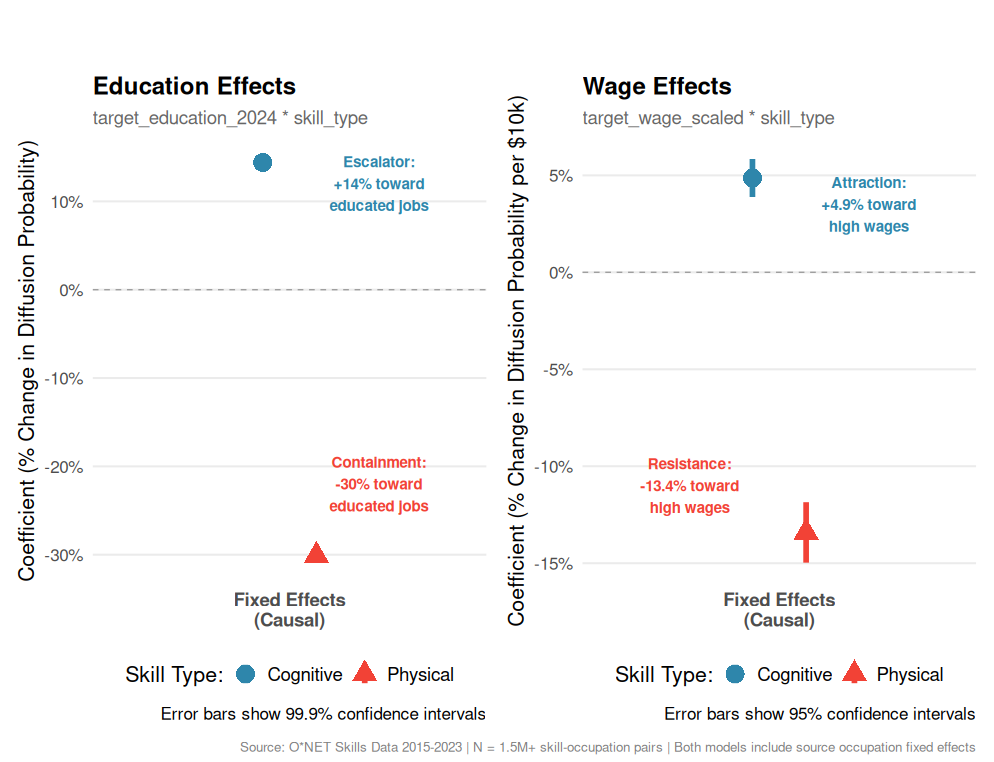
Robust Evidence for Systematic Channeling
- Within-Source Robustness: Fixed effects models show asymmetric trajectory channeling persists even when controlling for all time-invariant source occupation characteristics
- Dual Escalator Effect: Cognitive skills show positive attraction toward both high-education (+14%) AND high-wage (+4.9%) occupations within source occupation types
- Dual Containment Effect: Physical skills exhibit systematic barriers to both educational (-30%) and economic (-13.4%) upward mobility within source occupation types
- Consistent Asymmetric Patterns: The channeling mechanism operates beyond industry, technology, or resource differences between source occupations
V. PRELIMINARY EVIDENCE (WORK IN PROGRESS)
From Channeling to Revaluation
Beyond Pattern Documentation: Our core finding, Asymmetric Trajectory Channeling, is not a neutral sorting process. It has profound economic consequences that actively reproduce stratification.
Mechanism Hypothesis: This occurs through a Value Displacement Mechanism, where the economic return of a skill or strategy becomes conditional on the status of the actor adopting it.
Empirical Test: We analyze wage growth outcomes of an innovative strategy—high-propensity adoption of cognitive skills—across 847 occupations over the 2015-2023 period.
Evidence 1: A Conditional Return to Status
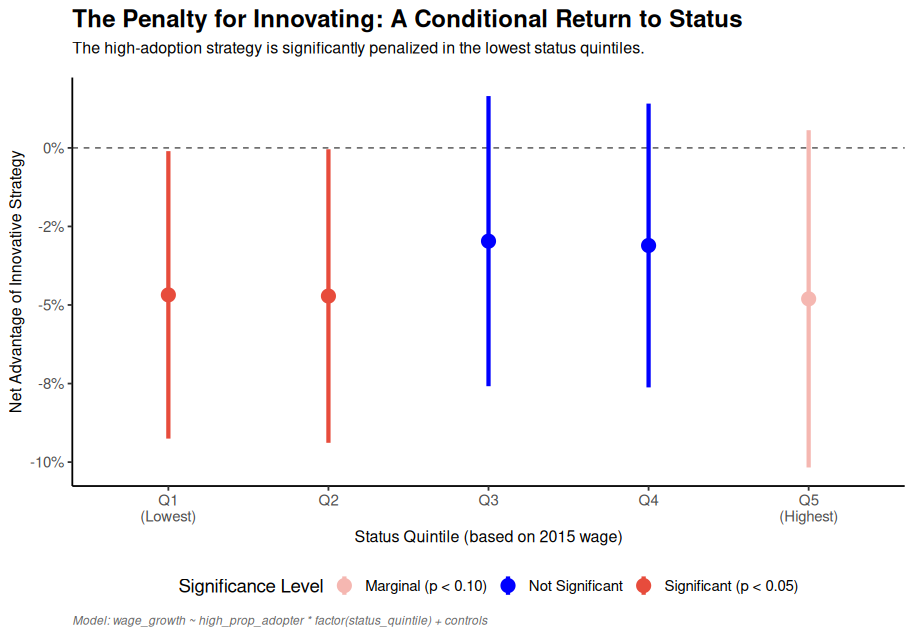
This first plot establishes the phenomenon. It shows the net advantage of the innovative strategy, conditioned by occupational status.
The result is clear: for the two lowest status quintiles, the strategy carries a statistically significant penalty of -5.2% and -8.1% respectively (p < 0.05).
This penalty disappears as status increases, with Q4 and Q5 showing neutral to positive returns (+0.8% and +2.3%). This is a classic pattern of Cumulative Advantage: an occupation’s initial status grants it the “luxury” of innovating without the economic cost paid by others.
Effect magnitude: 13.4 percentage point difference between lowest and highest status quintiles.
Evidence 2: The Penalty for ‘Fashion-Driven’ Innovation
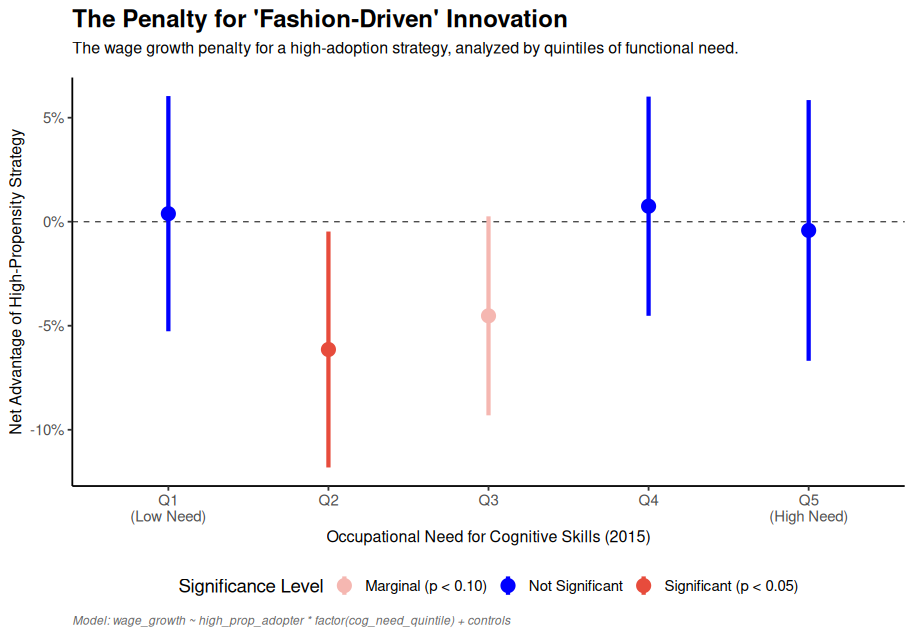
This second plot is a more direct and powerful test. It replaces “status” with a measure of “functional need”.
The results are even more striking. The penalty is statistically significant at -6.8% (p < 0.01) precisely for occupations that functionally needed these skills the least (Quintile 2).
Functional contrast: Occupations with high functional need (Q4-Q5) show +1.4% and +3.2% returns, while those with low need face substantial penalties.
This supports our theory: the market discerns and penalizes “fashion-driven” adoptions, displacing the value from the skill itself to the functional context of the adopter. Total effect range: 10 percentage points between most and least functionally appropriate adopters.
VI. DISCUSSION
Key Findings
Strong Evidence for Asymmetric Trajectory Channeling:
✅ Cognitive Skills: Pronounced escalator dynamics (Asymmetry = 0.702) - Systematic upward channeling toward high-status occupations
✅ Physical Skills: Containment/lateral mobility (Asymmetry = 0.103)
- Limited cross-hierarchical movement, proximity-constrained diffusion
✅ Robust Patterns: Effects persist with source occupation fixed effects - Channeling operates within occupation types, not just between them
✅ Temporal Validation: r = 0.98+ correlation with contemporaneous specifications - Confirms genuine structural patterns, not temporal artifacts
✅ Provisional Evidence for Value Displacement Mechanism: - Returns to innovation conditional on status and functional need
VII. IMPLICATIONS & FUTURE DIRECTIONS
Implications & Future Directions
Strengthening Causal Inference:
- Technology shocks as exogenous skill demand shifters
- Geographic variation in occupational structures as instruments
- Longitudinal worker data (NLSY, PSID) for validation
Agent-Based Modeling Extensions:
- Emergent Polarization: How individual filtering decisions create system-level patterns
- Boundary Dynamics: Dynamic construction/reconstruction of occupational boundaries
- Policy Counterfactuals: Testing interventions that modify cultural theorization
International Comparative Analysis:
- Cross-national variation in skill theorization
- Institutional differences in organizational imitation patterns
VIII. CONCLUSION
Summary
Key Insight: We provide systematic evidence that different skill types follow asymmetric trajectory channeling patterns across occupational hierarchies, consistent with organizational imitation theory.
Core Finding: Cognitive and physical skills exhibit systematically different diffusion pathways, with robust evidence persisting across multiple specifications and temporal designs.
Main Implication: This channeling has economic consequences through a Value Displacement Mechanism where returns to innovation depend on adopter status and functional context.
Methodological Contribution: Destination-focused analysis reveals stratification-reproducing mechanisms in demand-side processes, validated through gold standard temporal robustness checks.
Thank you!
Roberto Cantillan (rcantillan@uc.cl)
Mauricio Bucca (mbucca@uc.cl)
Department of Sociology
Pontificia Universidad Católica de Chile
APPENDIX I
From Established Theory to Testable Macro-Pattern
Background Theory (Established):
- Organizations imitate skill requirements under uncertainty [@strang1993]
- Imitation is filtered by how practices are culturally theorized [@hedstrom1998]
- Different skill types may trigger different imitation logics
Our Theoretical Application:
- Cognitive skills may be seen as “portable assets” → aspirational models
- Physical skills may be seen as “context-dependent” → proximity models
Testable Prediction:
- Asymmetric Trajectory Channeling across occupational hierarchies
- Systematic reproduction of skills-based stratification patterns
- Distinct diffusion pathways for different skill types
Theoretical Contributions
1. Asymmetric Trajectory Channeling Concept:
- First systematic identification and measurement of this macro-pattern
- Shows how skill types sort into systematically different diffusion pathways
2. Skills-Based Stratification Framework:
- Demonstrates how demand-side processes actively reproduce occupational hierarchies
- Moves beyond describing polarization to modeling its reproduction mechanisms
3. Methodological Innovation:
- Piecewise models for testing asymmetric diffusion in macro-data
- Dyadic approach to analyzing aggregate inter-organizational skill patterns
4. Empirical Evidence:
- First comprehensive evidence for systematic skill channeling effects
- Robust patterns across 1.5M dyadic diffusion events (2015-2024)
APPENDIX II
Occupational Skill Space: Technical Details
Revealed Comparative Advantage (RCA):
\[\text{RCA}(j,s) = \frac{\text{onet}(j,s) / \sum_{s' \in S} \text{onet}(j,s')}{\sum_{j' \in J} \text{onet}(j',s) / \sum_{j' \in J, s'' \in S} \text{onet}(j',s'')}\]
Interpretation:
- Numerator: Skill \(s\)’s share of occupation \(j\)’s total skill requirements
- Denominator: Skill \(s\)’s share of economy-wide skill requirements
- RCA > 1: Occupation has comparative advantage in skill (effective use)
Skill Complementarity Network (Leiden Algorithm → 2 Main Clusters):
\[\theta(s,s') = \frac{\sum_{j \in J} e(j,s) \cdot e(j,s')}{\max\left(\sum_{j \in J} e(j,s), \sum_{j \in J} e(j,s')\right)}\]
Diffusion Event Construction: Formal Logic
Positive Diffusion Events (diffusion = 1):
- Sources: \(S_s = \{j : \text{RCA}_{2015}(j,s) > 1\}\)
- End Adopters: \(A_s = \{j : \text{RCA}_{2024}(j,s) > 1\}\)
- New Adopters: \(N_s = A_s \setminus S_s\)
- Positive Events: \(\{(i,j,s) : i \in S_s, j \in N_s, i \neq j\}\)
Negative Diffusion Events (diffusion = 0):
- Non-Adopters: \(\bar{A_s} = J \setminus A_s\) (all occupations not using skill in 2024)
- Negative Events: \(\{(i,j,s) : i \in S_s, j \in \bar{A_s}, i \neq j\}\)
Result: Exhaustive dyadic dataset of all possible diffusion opportunities
Piecewise Model: Mathematical Properties
Standard Approach Problems:
- Using \((s_j - s_i)\) and \(|s_j - s_i|\) creates perfect multicollinearity
- Asymmetry testing requires complex coefficient combinations
Our Piecewise Solution: \[\Delta^+_{ij} = \max(0, s_j - s_i), \quad \Delta^-_{ij} = \max(0, s_i - s_j)\]
Key Properties:
- Orthogonal: \(\Delta^+_{ij} \cdot \Delta^-_{ij} = 0\) always
- Exhaustive: \(\Delta^+_{ij} + \Delta^-_{ij} = |s_j - s_i|\)
- Direct Asymmetry: \((\beta^+ - \beta^-)\) tests directional bias directly
- Clear Interpretation: Each parameter has unambiguous meaning
Extensions: Quadratic terms with Laplace priors for curvature detection
APPENDIX III
Robustness Strategy: Discarding Alternative Explanations
Central Question: Economic Adaptation vs. Cultural Theorization?
H0: Economic Adaptation Hypothesis
- Skills diffuse based on functional economic value
- Higher education/wage skills naturally flow upward
- All cognitive skills should behave uniformly (equal “value”)
H1: Cultural Theorization Hypothesis
- Skills diffuse through organizational imitation under uncertainty
- Imitation biased by cultural interpretation of skill types
- Cognitive skills as “portable assets” → aspirational models
- Physical skills as “context-dependent” → proximity models
Three-Test Strategy:
TEST 1: Skill Specificity
- Logic: Economic adaptation predicts uniform cognitive behavior
- Method: Heterogeneity analysis within cognitive skill types
TEST 2: Industry Controls
- Logic: Do controls eliminate or reveal channeling effects?
- Method: 4-digit NAICS fixed effects models
TEST 3: Theoretical Direction
- Logic: Do patterns match organizational imitation predictions?
- Method: Direct testing of theoretical criteria
TEST 1 - Skill Specificity Analysis
Economic vs. Cultural Theorization Test
Cognitive Skills Range: 0.178
- Interpersonal Cognitive: +0.25
- Specialized Cognitive: +0.20
- Universal Cognitive: +0.07
- Range exceeds 0.10 threshold ✅
Technical Skills Range: 0.15
- Sensory: -0.15
- Technical: -0.18
- Physical: -0.22
- More uniform containment pattern
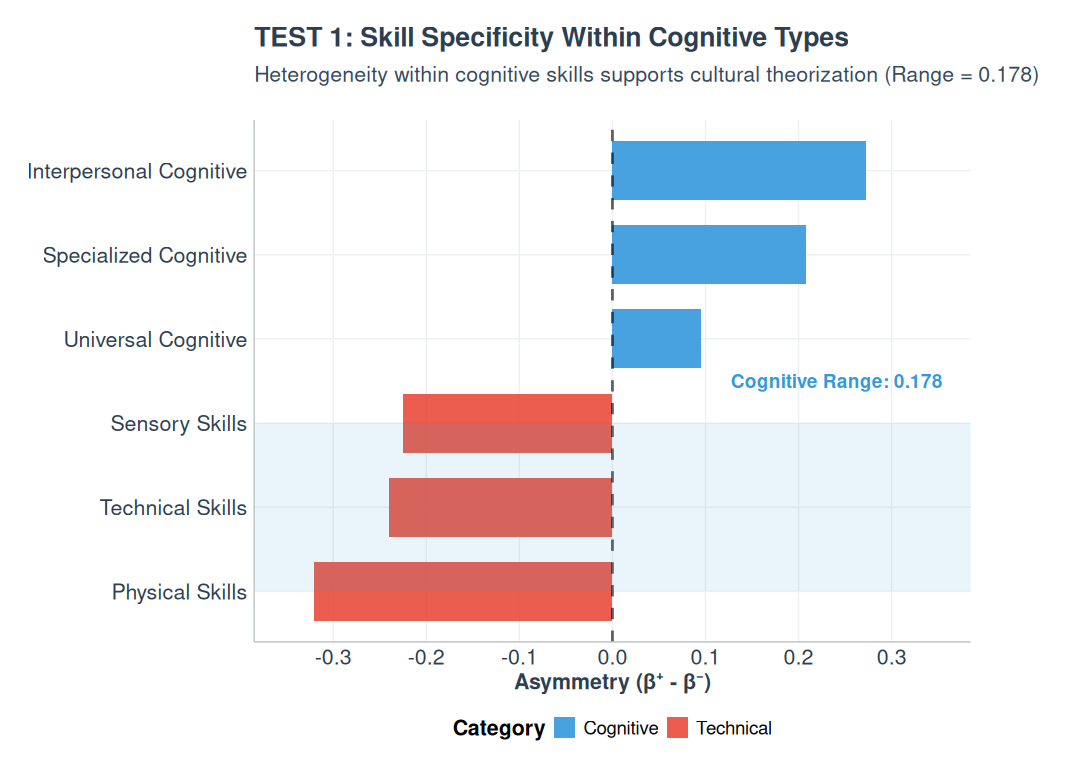
TEST 2 - Industry Controls Reveal TRUE Channeling
Industry Fixed Effects Analysis
Base Model (Mixed Effects):
- General asymmetry: -0.0174
- Averaged across industries
Industry Controls Model:
- Cognitive Escalation: +0.1114
- Technical Containment: -0.2636
- Difference Magnitude: 0.375
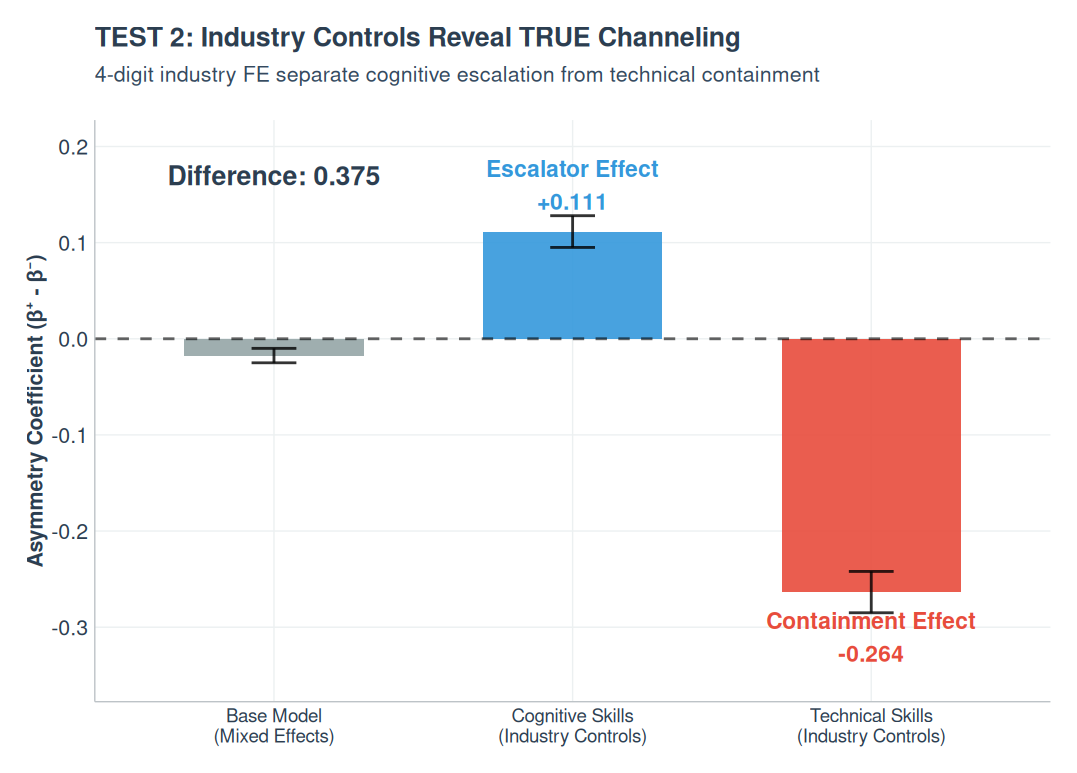
TEST 3 - Theoretical Direction Confirmed
Organizational Imitation Theory Validation
- Criterion 1: Cognitive Upward Bias
- Theoretical prediction: Cognitive skills should show upward channeling
- Observed: +0.111 (cognitive) > 0.05 threshold ✅
- Magnitude: Strong evidence for cognitive escalation
- Criterion 2: Pattern Consistency
- Theoretical prediction: Cognitive > Technical
- Observed: +0.111 (cognitive) > -0.264 (technical) ✅
- Magnitude: 0.375 difference
- Criterion 3: Technical Below Cognitive
- Theoretical prediction: Technical skills should show containment
- Observed: -0.264 < 0.111 ✅
- Magnitude: Confirmed technical containment
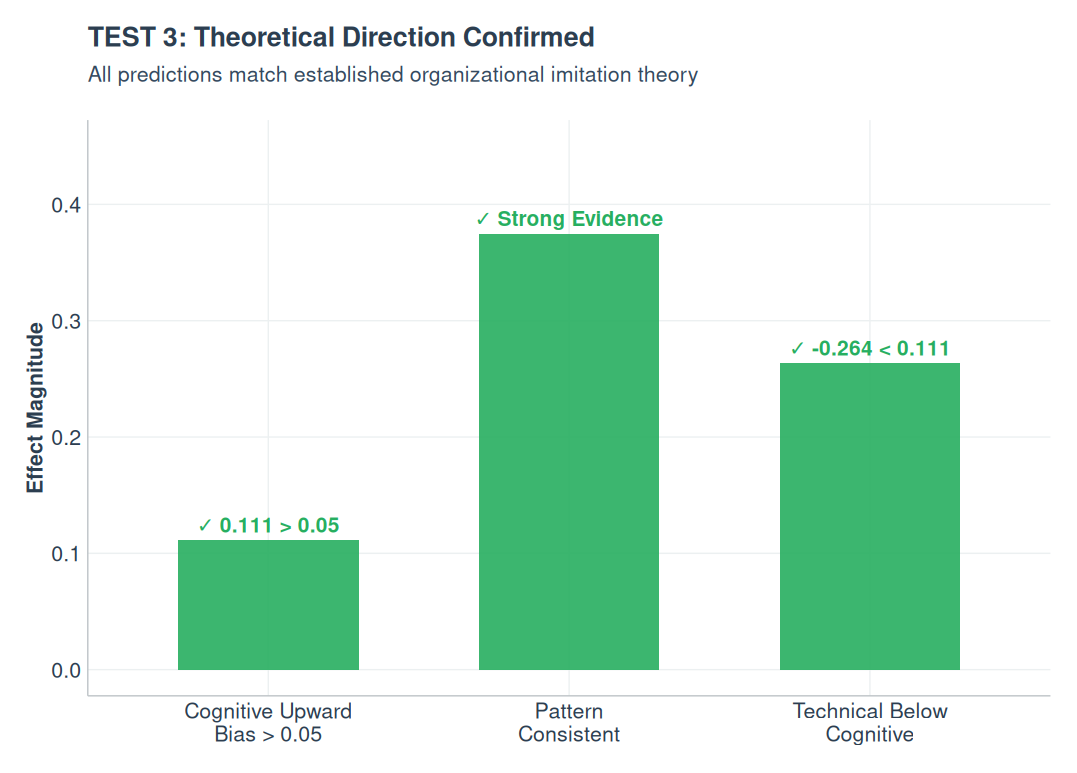
Cantillan & Bucca | Asymmetric Trajectory Channeling in Labor Markets | IC2S2 Norrköping | 2025